Accelerating Transitions in Hybrid Environments
In this episode of the Freshteams Leadership Podcast, the hosts interviewed Genesis cofounder, leadership transitions expert, and Thinkers 50-ranked management influencer Michael Watkins about how organizations can effectively onboard new leadership talent in a hybrid/remote work environment – something many companies are grappling with as they emerge from the COVID-19 crisis. Below is a summary of the conversation including the presentation slides that Michael shared with us during the video podcast interview.
The key is to adapt processes that were part of the onboarding program in an in-person setting to fully virtual, aiming for a similar effect. Before the pandemic, we used a process called 'New Leaders Simulation' and 'New Team Members' Simulation' to help form and deepen connections between leaders and their teams. The process consisted of 3- to 4-hour, in-person interviews of individual team members to understand what they wanted their leaders to know about them and vice-versa. You can still do that in the virtual setting, but you need a different approach.
To illustrate his point, Michael shared an example drawing on his recent experience coaching a CEO of a large healthcare system in the US, who is operating 100% remotely with his team. Instead of running 3- to 4-hour virtual interviews with each of his team members, he ran a survey focusing on challenges, opportunities, what they would focus on if they were in his position, what they wanted to know about the CEO, and what the CEO should know about them. The survey was followed by an hour-long virtual session with each team member. The CEO's team was incredibly open with their feedback, which Michael collated and shared with him. This revised approach helped form connections between the CEO and his team members in a short time.
With most of us working from home and with organizations deciding their future course of action, it is imperative to focus on the effective onboarding of new hires and those transitioning to new internal roles considering that:
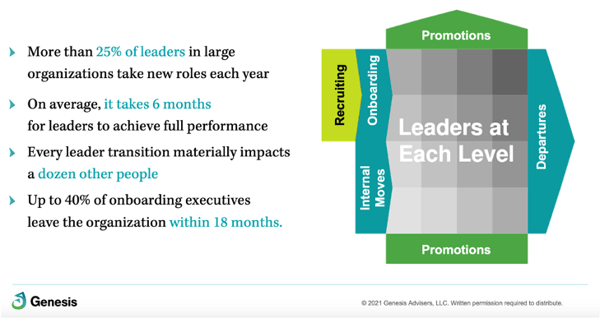
Given the constant churn of human capital through organizations depicted above, Michael urges us to think about the systemic impact of transitions in terms of the number of people hired from outside and those taking up new roles internally. How big a deal is it to you that they do well; that they accelerate their transitions; that they come up to speed and start having an impact right away? Doing this mental exercise is a good place to start.
Top two reasons why onboarding fails
Even before the current crisis, onboarding was not an easy thing to do. Research consistently demonstrates that the failure rates of new leaders hired from the outside are high, especially at more senior levels. Typically, that failure is not due to their inherent incompetence, lack of leadership capabilities, or inability to design a new strategy; it is due to two things: culture and politics.
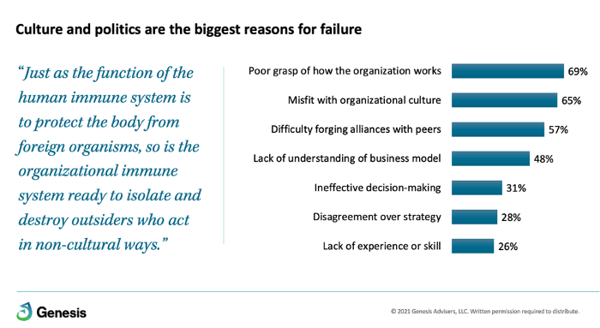
As you can see, the top three causes of derailment have to do with new hires not meshing with the organizational culture and being unable to form alliances with peers to reach shared goals.
According to Michael, the culture of an organization functions like the organization's immune system. It's there to keep bad things from showing up and taking root. It reacts if you do things that are not in line with the accepted norms. So, even before we talk about remote work settings, understand that the core of proper onboarding is about how you successfully integrate people into a culture and a new social system.
Go beyond orientation
Proper onboarding is about successfully integrating people into the organization and not merely orienting them, although that is also essential. When someone joins an organization, you want them to be signed up, given access to systems and technology, etc. - most organizations do a pretty good job of that (see bar graph below).
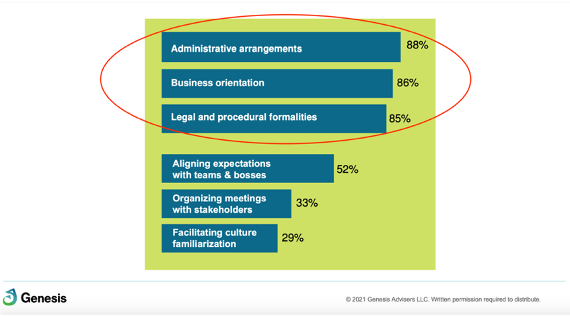
Far fewer organizations take the necessary additional steps to ensure that the new hire aligns with their boss, team, and organization. New employees need to establish connections with key stakeholders. They also need to familiarize themselves with the organizational culture, which is perhaps the most critical piece.
For most organizations, the executive onboarding process covers what Michael calls “onboarding hygiene” — orienting people, signing them up, and getting all the compliance work done. They overlook or ignore the vast chunks of value associated with alignment with bosses, teams, stakeholder connections, and cultural adaptation. Yet, if you combine the basic elements (circled above) and the integration elements (circled below) the result is a robust onboarding and integration system.
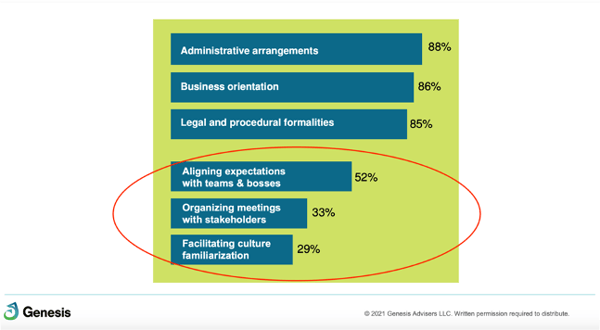
Classic "transition" mistakes organizations and leaders make
Another related area that Michael drew our attention to during our interview — and the subject of his Harvard Business Review article, “Internal Hires Need Just as Much Support as External Ones” — is the fact that very few companies focus on internal moves and do enough to support them. As depicted in the chart below, a higher percentage of organizations focus more on onboarding executives and lower-level leaders than on those moving to new roles within an organization, especially at the executive levels.
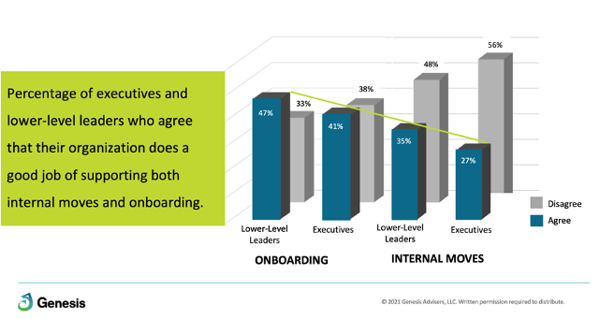
Michael says that organizations must accelerate the transitions of all leaders taking new roles – whether externally hired or internally promoted. Each leader who takes a new role is making a critical move and the impact they have on their teams, function, and on the organization, is more significant than it one can imagine on the surface. Fortunately, if you adopt a common framework, the tools used to onboard external hires can also be used to accelerate internal transitions.
While the onus is on organizations to help speed up and support transitions, leaders taking new roles must also act responsibly to ensure their own success. Through his academic and practical experience coaching leaders in transition across several decades, Michael has identified some of the classic traps leaders fall into while making transitions:
- Sticking with what you know: Leaders tend not to understand the new context they are placed in and are stuck with how they did things in their previous
- Coming in with "the answer": This stems from a prejudiced frame of mind where they think they know what to do in a particular role and refuse to change their stance despite compelling opposite
- Falling prey to the "action imperative": Newly hired leaders feel pressure to perform and sometimes this pressure forces them to act in haste, resulting in knee-jerk
- Setting unrealistic expectations: Many leaders, eager to prove their value to the organization, attempt to do too much at the outset. Instead, they should align with their bosses and other key stakeholders and set manageable expectations.
- Attempting to do too much: New leaders, keen to make their mark in a new role, can end up spreading themselves too thin, resulting in missteps and
- Engaging in the wrong types of learning: Most often, leaders focus on learning the technical aspects of their job and neglect the cultural and political
- Neglecting peer relationships: Leaders tend to spend a lot of time building relationships with their managers and reports, but not with their peers. In so doing, they fail to form key lateral alliances that can prove crucial to their future success.
If you look at these seven pitfalls through the lens of remote work, you can understand how onboarding and integrating leaders becomes even more challenging.
Throughout his career at Genesis Advisers, Michael has applied the framework he codified in The First 90 Days, in helping countless leaders successfully navigate their transitions into new roles. Some of the elements of his Transition Roadmap® framework include: 1) being systematic about some critical things such as speeding up the learning process, 2) making sure you're adapting your strategy to the business situation, 3) gaining that critical alignment with your manager, 4) building (or reshaping) the team you inherit, 5) securing early wins, and 6) creating alliances.
The main point here is recognizing the power of having a common framework and language to accelerate leadership transitions at scale within your organization. Of course, it also helps to have clear definition around the roles that key stakeholders play in the executive onboarding process.
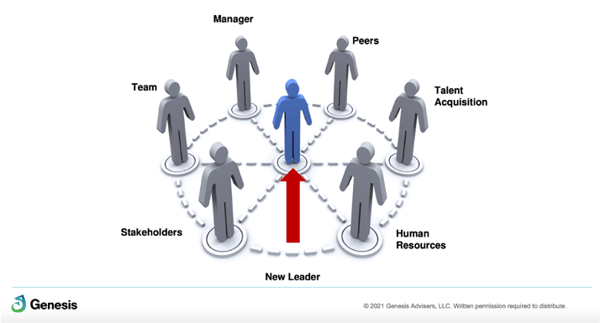
In his article, “How to Onboard New Hires at Every Level,” (HBR.org, June 2019), Michael points out that there tends to be insufficient ownership of the onboarding process in many organizations. He says it's helpful to describe the process and to think about the pivotal roles people and tools play in executive onboarding. He adds that it needn't be complicated.
Challenges of leadership, onboarding, and transitions in the COVID-19 era
According to Michael, we are facing some of the biggest challenges in modern times due to the pandemic, and businesses are doing the best they can to adapt to the crisis. The top four leadership challenges that companies are grappling with are:
- The existing talent needs to be re-deployed and, in many cases, stretched to meet new demands.
- Organizations need to bring in new leadership capabilities to fill skill gaps and support innovation.
- There’s an increased demand and need for digital expertise across functions.
- Onboarding new hires and promoting leaders in remote, hybrid, and in-person work environments.
Onboarding new hires and helping those undergoing internal transitions now requires leadership capabilities we didn't even think we needed before the pandemic. Developing these new leadership capabilities is especially challenging, given that we are operating in virtual and hybrid settings.
Paradoxically, whenever organizational stress increases, companies tend to focus less on onboarding even though it is arguably even more critical that they get it right. Below are just a few of the added challenges to onboarding new leaders arising from the COVID-19 crisis:
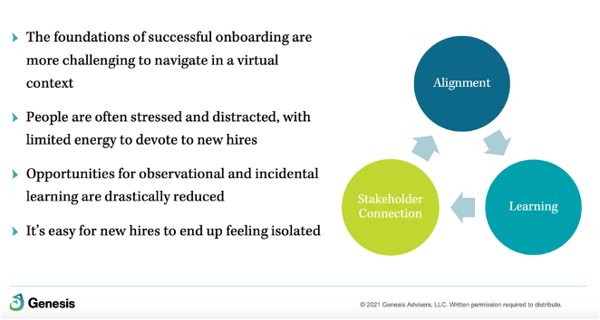
Four pillars of making virtual onboarding & transitions happen in the COVID-19 era
Michael has been coaching senior executives of global organizations for many years at Genesis Advisers and in his experience, one-on-one interactions – be it coaching, interviews, or even negotiations – are about 90% as effective virtually as they are in person.
However, the virtual mode is not as effective for fostering broader network synergies and forming team connections – a crucial part of the executive onboarding process. To provide new hires with sufficient guidance, Michael recommends a structured onboarding program based on the four pillars outlined below.
Alignment:
- Give your new hires specific guidance about how they can create value right away: Without this, the new hires will find it challenging to connect with key stakeholders and are all too easily shunted aside.
- Focus on specific, short-term objectives: Lay a clear path for the new hires outlining what the organization expects them to deliver.
- Provide guidance on the "how" (strategy) and not just the "what" (goals): Organizations cannot leave their new hires in the dark and expect them to intuit the business goals; they need to be explicit.
- Hiring managers and HR partners should proactively check-in more in the initial weeks: Though this might be a bit overwhelming for the hiring managers and HR leaders, it is critical for the onboarding success of the new Imagine having to join an organization remotely and feeling a sense of isolation right from the very start!
Connection:
Michael asks: “Before COVID, do you remember walking into people's cubicles or offices, shaking hands (We didn't even know there was a term called "social distancing" then, did we?) and having a casual chat to figure out what you need to do and who you should connect with? It seems like a distant memory, right? (I see you sighing deeply. Hang in there!)”
In the absence of such easy communication channels, it is incumbent on the organization to be very specific about who their new hires need to meet with, and why. To do this, organizations must create an effective stakeholder engagement plan that helps the new hire, as follows:
- Identify who the primary stakeholders are
- Provide clarity on the order in which the new employee should meet with them
- Tell the various stakeholders why the new person has joined and what impact they will create on the team and organization
- Set clear goals for the new employee to engage with the stakeholders.
A robust stakeholder engagement plan can have an enormous impact on the confidence of the newly hired or promoted leader. A systematic approach makes the onboarding process easier and has a profoundly positive effect on the new employee, his or her team, and the company.
Teams:
Team building has taken on a different dimension in the virtual work context, especially concerning working with remote teams and the implications for onboarding into a new team. There are two scenarios in such cases: 1) becoming a new member of a team, and 2) becoming a new leader of a team. The goal here is to rapidly connect the new member/leader with the other teammates and ensure a smooth workflow by:
- Providing as much information about team members as possible, up front
- Facilitating virtual introductions between the new hire and the team
- Supporting micro team-building exercises
- Conducting rapid, cut-down virtual versions of new leader assimilation and new team member assimilation (with the hiring manager's team).
In his article, “How to Onboard a New Leader – Remotely” (HBR.org, May 2020) Michael points out that there are natural limitations to what you can do in the virtual environment with teams. The virtual environment is pretty good for coordination and information-sharing. However, when it comes to deep collaboration, innovation, and building a shared culture, we are still unable to do it the way we would in an in-person setting. However, there are essential things organizations can do to help integrate team members and new leaders into teams in remote settings, outlined below.
Support:
Michael is a proponent of assigning “virtual onboarding buddies” — building on the buddy system organizations, like Microsoft used before the crisis, in which an existing employee volunteers to shadow someone joining the organization. Good "buddies" help new employees in four key areas:
- Orientation to the business
- Connection to key stakeholders
- Navigation to processes and systems
- Acceleration of acculturation
Implementing a buddy system is more important in a virtual work context because each person is operating as an island and there are fewer opportunities for the informal or observational learning that happen in a physically co-located environment. It's essential to pick the right employees to act as "buddies" — those who know the organization, history, and culture are often the best bets.
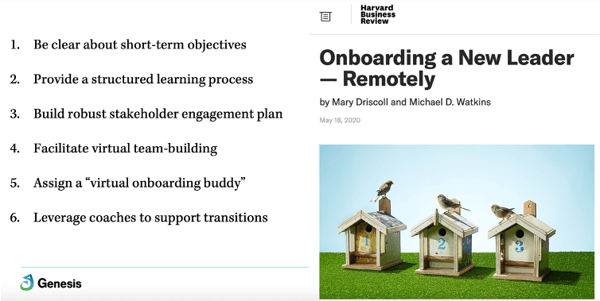
In summary, here are the key takeaways from Michael's Freshteam Leadership Podcast interview:
- Onboarding and accelerating transitions, especially internal moves, have gained even more prominence in virtual work environments.
- Culture and politics are the two biggest reasons why onboarding fails.
- Onboarding doesn't just mean orientation; it also includes integration.
- Organizations often ignore internal moves and "hidden transitions", whereas the same tools used for onboarding external hires can help accelerate such transitions.
- New leadership challenges have emerged in the COVID-19 era, such as the need for redeployment of talent, new leadership capabilities, heightened demand for digital expertise; and onboarding leaders in virtual, hybrid, and in-person work environments.
- Four pillars to help onboarding and accelerating transitions in the current work environment: Alignment, Connection, Teams, and Support (Buddy system).
Follow this link to listen to the Freshteams Podcast featuring Michael Watkins.

Genesis
Genesis is a global provider of leadership development programs, coaching, and transition acceleration solutions for individuals, teams, and organizations. Genesis offerings are based on the research of Michael Watkins, co-founder and author of the book "The First 90 Days." Genesis provides a comprehensive range of programs, coaching processes, and consulting services aimed at speeding up transitions at all levels, from front-line managers to C-level executives.